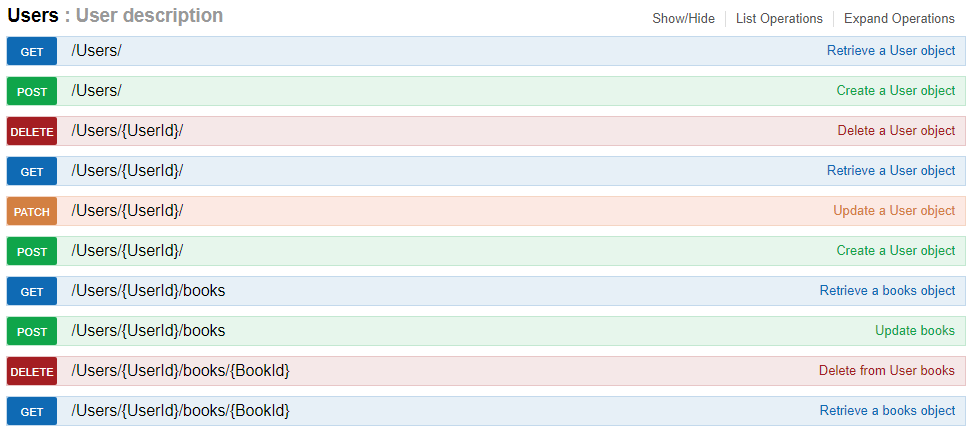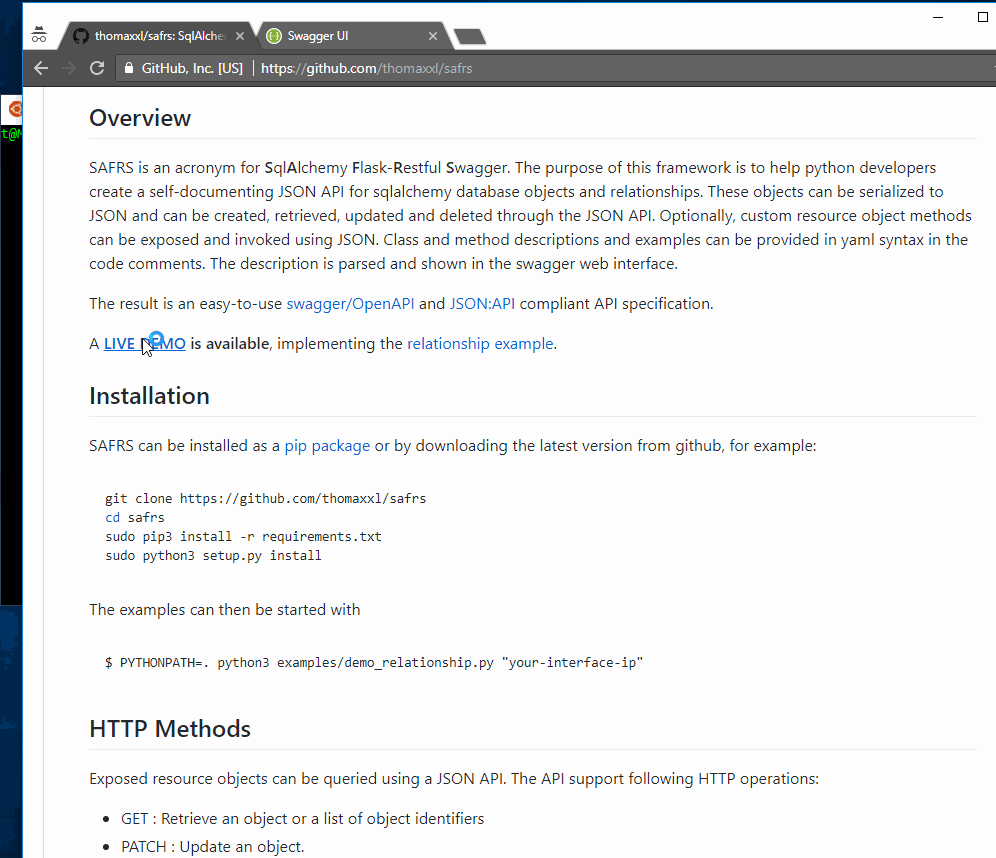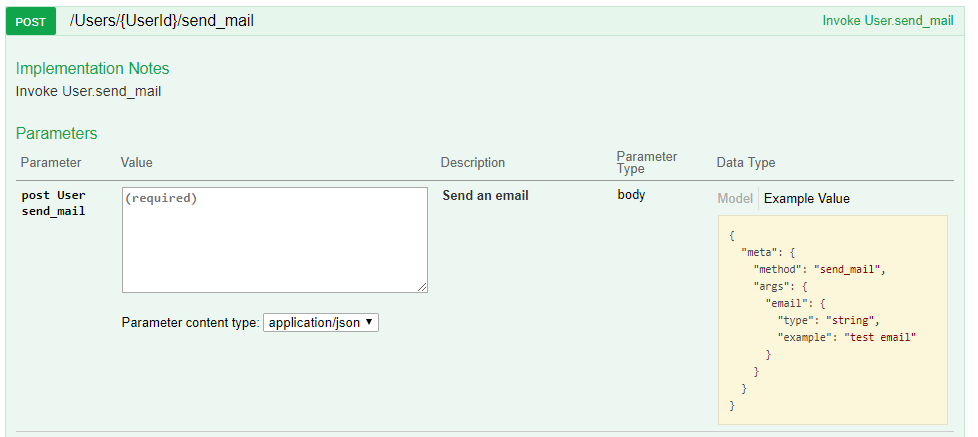thomaxxl / Safrs
Programming Languages
Projects that are alternatives of or similar to Safrs
SAFRS: Python OpenAPI & JSON:API Framework
- Overview
- Installation
- JSON:API Interface
- Resource Objects
- Relationships
- Methods
- Initialization
- Endpoint Naming
- Configuration
- Exposing Existing Databases
- More Examples and Use Cases
- Advanced Usage
- Limitations & TODOs
- References
- Thanks
Overview
SAFRS is an acronym for SqlAlchemy Flask-Restful Swagger. The purpose of this framework is to help python developers create a self-documenting JSON API for sqlalchemy database objects and relationships. These objects can be serialized to JSON and can be created, retrieved, updated and deleted through the JSON API. Optionally, custom resource object methods can be exposed and invoked using JSON. Class and method descriptions and examples can be provided in yaml syntax in the code comments. The description is parsed and shown in the swagger web interface.
The result is an easy-to-use swagger/OpenAPI and JSON:API compliant API implementation.
A LIVE DEMO is available, where much of the basic functionality is implemented with a simple example.
UPDATE! documentation can be found in the wiki.
Installation
SAFRS can be installed as a pip package or by downloading the latest version from github, for example:
git clone https://github.com/thomaxxl/safrs
cd safrs
pip install .
Once the dependencies are installed, the examples can be started with
python3 examples/demo_relationship.py "your-interface-ip"
JSON:API Interface
Exposed resource objects can be queried using the JSON:API format. The API supports following HTTP operations:
- GET : Retrieve an object or a list of objects
- PATCH : Update an object.
- DELETE: Delete an object.
- POST : Create an object.
Please check the JSON:API spec for more implementation details. You can also try out the interface in the live demo.
Resource Objects
Database objects are implemented as subclasses of the SAFRSBase and SQLAlchemy model classes. The SQLAlchemy columns are serialized to JSON when the corresponding REST API is invoked.
Following example app illustrates how the API is built and documented:
class User(SAFRSBase, db.Model):
"""
description: User description
"""
__tablename__ = "Users"
id = db.Column(db.Integer, primary_key=True)
name = db.Column(db.String)
email = db.Column(db.String)
The User class is implemented as a subclass of
- db.Model: SQLAlchemy base
- SAFRSBase: Implements JSON serialization for the object and generates (swagger) API documentation
This User object is then exposed through the web interface using the Api object
api.expose_object(User)
The User object REST methods are available on /User, the swagger schema is available on /api/swagger.json and the UI is available on /api/:

Relationships
Database object such as the User class from the demo.py example can be extended to include relationships with other objects. The demo_relationship.py contains following extension of the User class where a relationship with the Book class is implemented:
class User(SAFRSBase, db.Model):
'''
description: User description
'''
__tablename__ = 'Users'
id = db.Column(db.String, primary_key=True)
name = db.Column(db.String, default='')
email = db.Column(db.String, default='')
books = db.relationship('Book', back_populates="user")
...
A many-to-one database association is declared by the back_populates relationship argument. The Book class is simply another subclass of SAFRSBase and db.Model, similar to the previous User class:
class Book(SAFRSBase, db.Model):
'''
description: Book description
'''
__tablename__ = 'Books'
id = db.Column(db.String, primary_key=True)
name = db.Column(db.String, default='')
user_id = db.Column(db.String, db.ForeignKey('Users.id'))
user = db.relationship('User', back_populates='books')
The User.book relationship can be queried in the API through the following endpoints:

- POST adds an item to the relationship
- DELETE removes an item from the relationship
- GET retrieves a list of item ids
The relationship API endpoints work similarly for one-to-many relationships.
Relationship members can also be included in the response when querying an instance, by specifying the relationship names as a comma separated list in the include query argument.
For example, to retrieve all items in the books_read relationship from the People endpoint, you may add the include=books_read url parameter
http://thomaxxl.pythonanywhere.com/api/People/?include=books_read
To retrieve nested relationship items, you can specify the nested relationship name after the '.', to retrieve the authors of the books_read instances for instance, you can use
http://thomaxxl.pythonanywhere.com/api/People/?include=books_read.author
Methods
Custom Methods
Safrs allows the user to implement custom methods on the exposed objects. This methods can be invoked through the json API by sending an HTTP POST request to the method endpoint The following example implements a "send_mail" method fro example:
class User(SAFRSBase, db.Model):
'''
description: User description
'''
__tablename__ = 'Users'
id = Column(String, primary_key=True)
name = Column(String, default='')
email = Column(String, default='')
# Following method is exposed through the REST API
# This means it can be invoked with a HTTP POST
@jsonapi_rpc(http_methods=['POST','GET'])
def send_mail(self, email):
'''
description : Send an email
args:
email:
type : string
example : test email
'''
content = 'Mail to {} : {}\n'.format(self.name, email)
return { 'result' : 'sent {}'.format(content)}
This method shows up in the swagger interface:
The send_mail method is documented with the jsonapi_rpc decorator.
This decorator generates a schema based on the function documentation. This documentation contains yaml specification of the API which is used by the swagger UI.
api_methods.py contains a couple of methods that can be used in your models.
The yaml specification has to be in the first part of the function and class comments. These parts are delimited by four dashes ("----") . The rest of the comment may contain additional documentation.
Class Methods
Two class-level methods have been defined to facilitate object retrieval:
- lookup : retrieve a list of objects that match the argument list. For example, following HTTP POST request to a container will retrieve a list of itemswhere the name is "thomas"
{
"method": "lookup",
"args": {
"name": "thomas"
}
}
- get_list : retrieve a list of the items with the specified ID's
Application Initialization
The API can be initialized like this:
api = SAFRSAPI(app, host=HOST, port=PORT, prefix=API_PREFIX)
Then you can expose objects with
api.expose_object(User)
An example that uses the flask app factory pattern is implement in examples/mini_app.py
app.config.update(DEBUG=True)
Endpoint Naming
As can be seen in the swagger UI:
- the endpoint collection path names are the SQLAlchemy __tablename__ properties (e.g. /Users )
- the parameter names are derived from the SAFRSBase class names (e.g. {UserId} )
- the the relationship names are the SAFRSBase class relationship names (e.g /books ) The URL path format is configurable
Configuration
Some configuration parameters can be set in config.py:
- USE_API_METHODS: set this to false in case you want to disable the
jsonapi_rpcfunctionality - INSTANCE_URL_FMT: This parameter declares the instance url path format
- RELATIONSHIP_URL_FMT: This parameter declares the relationship endpoint path format
Exposing Existing Databases
Safrs allows you to Expose existing databases as jsona:api services with the expose_existing.py script, for example:
python3 expose_existing.py mysql+pymysql://root:[email protected]/sakila --host localhost
This script uses sqlacodegen to generate a source file containing the SQLAlchemy and SAFRSBase database models and starts the API webservice.
More details here
More Examples and Use Cases
The examples folder contains more example scripts:
A docker image can be found here: https://github.com/thomaxxl/safrs-example
Advanced Usage
Filtering
The swagger shows the jsonapi filters that can be used in the url query arguments. Items with an exact match of the specified attribute value can be fetched by specifying the corresponding key-value query parameter. For example, suppose the User class, exposed at /Users has a name attribute, to retrieve all instances with the name "John", you can use a GET request to
/Users?filter[name]=John.
It is also possible to use more generic filters by specifiying a JSON string, for example filter=[{"name":"timestamp","op":"gt","val":"2020-08-01"},{"name":"timestamp","op":"lt","val":"2020-08-02"}].
More info can be found in the wiki.
Custom Serialization
Serialization and deserialization are implemented by the SAFRSBase to_dict and __init__ : you can extend these methods as usual.
For example, if you would like to add some attributes to the json payload of the User object, you can override the to_dict method:
class User(SAFRSBase, db.Model):
'''
description: User description
'''
__tablename__ = 'Users'
id = db.Column(db.String, primary_key=True)
name = db.Column(db.String, default='')
email = db.Column(db.String, default='')
books = db.relationship('Book', back_populates="user")
def to_dict(self):
result = SAFRSBase.to_dict(self)
result['custom_field'] = 'custom'
return result
This will add the custom_field attribute to the result attributes:
"attributes": {
"custom_field": "custom",
"email": "reader_email0",
"name": "Reader 0"
}
Excluding Attributes and Relationships
It is possible to specify attributes and relationships that should not be serialized by specifying the respective exclude_attrs and èxclude_rels` class attributes in your SAFRSBase instances.
Examples can be found here and here
Limiting HTTP Methods
It is possible to limit the HTTP methods that are allowed by overriding the http_methods class attribute. An example can be found here
HTTP Decorators
The decorators class attribute list can be used to add custom decorators to the HTTP endpoints. An example of this functionality is implemented
in the authentication examples.
API Methods
Some additional API RPC methods are implemented in api_methods.py, e.g. mysql regex search.
Custom swagger
The swagger schema can be merged with a modified schema dictionary by supplying the to-be-merged dictionary as the custom_swagger argument to SAFRSAPI, e.g.
custom_swagger = {"info": {"title" : "New Title" }} # Customized swagger title will be merged
api = SAFRSAPI(app, host=swagger_host, port=PORT, prefix=OAS_PREFIX, api_spec_url=OAS_PREFIX+'/swagger',
custom_swagger=custom_swagger, schemes=['http', 'https'], description=description)
Classes Without SQLAlchemy Models
You can implement a serializable class without a model but this requires some extra work because safrs needs to know which attributes and relationships to serialize. An example is implemented here
More Customization
The documentation is being moved to the wiki
Limitations & TODOs
This code was developed for a specific use-case and may not be flexible enough for everyone's needs. A lot of the functionality is available but not documented for the sake of brevity.
Performance is reasonable for regular databases, but once you start exposing really big tables you may run into problems, for example: the count() for mysql innodb is slow on large(1M rows) tables, a workaround can be implemented by querying the sys tables or using werkzeug caching.
Feel free to open an issue or drop me an email if you run into problems or something isn't clear!
References
Thanks
I developed this code when I worked at Excellium Services. They allowed me to open source it when I stopped working there.







